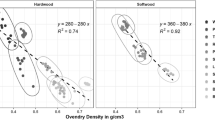Abstract
The objective of this study was to evaluate the effects of phenolic resin treatment on the strength improvement of jelutong wood. 30 % low molecular weight phenol formaldehyde resin (LmwPF) was used as treating solution. 30 % urea was incorporated into LmwPF resin to serve as the second type of treating solution. Impregnated and compregnated jelutong wood were produced using these two treating solutions. For compregnation process, 3 compression ratios (40, 60 and 80 %) were applied. A set of untreated jelutong wood was served as control. Formaldehyde emission, strength properties and specific strengths of the wood samples were evaluated. The results showed that the addition of urea had effectively reduced the formaldehyde emitted from the treated wood. No significant reduction in strength was reported accompanying by the addition of urea. Both density and mechanical properties of the compregnated wood are highly dependent on the compression ratio. Higher compression (lower CR) produced wood with higher density and modulus of rupture. In conclusion, phenolic resin treatments were found successfully enhanced the strength properties of jelutong wood.

Similar content being viewed by others
References
Adawiah MAR, Zaidon A, Nur Izreen FA, Bakar ES, Mohd Hamami S, Paridah MT (2012) Addition of urea as formaldehyde scavenger of low molecular weight phenol formaldehyde treated compreg wood. J Trop For Sci 24:265–274
Ang AF, Zaidon A, Bakar ES, Mohd Hamami S, Anwar UMK, Jawaid M (2014) Possibility of improving the properties of Mahang wood (macaranga sp.) through phenolic compreg technique. Sains Malays 43(2):219–225
Haygreen JG, Bowyer JL (1982) Forest products and wood science: an introduction. Iowa State University Press, Ames
Lee SH, Zaidon A (2015) Durability of phenolic-resin-treated sesenduk (Endospermum diadenum) and jelutong (Dyera costulata) wood against white rot fungus. Eur J Wood Wood Prod 73:553–555
Nabil FL, Zaidon A, Anwar UMK, Bakar ES, Paridah MT, Saliman MAR, Ghani MA, Lee SH (2015) Characterisation of phenolic resin and nanoclay admixture and its effect on impreg wood. Wood Sci Technol 49:1209–1224
Purba TP, Zaidon A, Bakar ES, Paridah MT (2014) Effects of processing factors and polymer retention on the performance of phenolic-treated wood. J Trop For Sci 26(3):320–330
Rowell RM (2005) Chemical modification of wood. In: Rowell RM (ed) Handbook of wood chemistry and wood composites. CRC Press, Florida
Zaidon A, Kim GH, Paridah MT, Bakar ES, Rushdan I (2012) Optimisation of the processing variables for high polymer loading in compressed wood using response surface methodology. J Trop For Sci 24(2):241–248
Zaidon A, Lee SH, Radzali MNE (2015) Effects of ammonium carbonate post treatment on phenolic resin treated sesenduk (Endospermum diadenum) wood. Sains Malays 44(7):987–994
Author information
Authors and Affiliations
Corresponding author
Rights and permissions
About this article
Cite this article
Ashaari, Z., Lee, S.H., Mustamel, M.N. et al. Strength improvement of jelutong (Dyera costulata) wood via phenolic resin treatments. J Indian Acad Wood Sci 12, 132–136 (2015). https://doi.org/10.1007/s13196-015-0156-0
Received:
Accepted:
Published:
Issue Date:
DOI: https://doi.org/10.1007/s13196-015-0156-0




